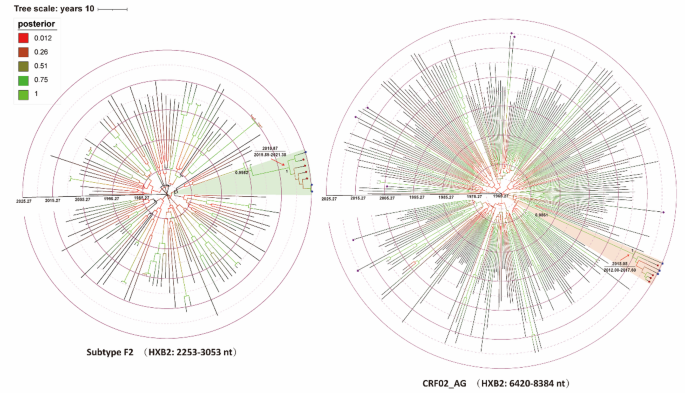Molecular characterization of a unique Recombinant form of HIV-1 subtype F2/CRF02_AG identified in Guangdong, China – Virology Journal

Introduction: Aligning HIV-1 Genetic Research with Sustainable Development Goal 3
The global effort to combat the HIV/AIDS epidemic is a cornerstone of the United Nations Sustainable Development Goal 3 (SDG 3), which aims to ensure healthy lives and promote well-being for all at all ages. Specifically, Target 3.3 calls for an end to the AIDS epidemic by 2030. Achieving this target necessitates a profound understanding of the Human Immunodeficiency Virus (HIV-1), particularly its extensive genetic diversity, recombination patterns, and the emergence of drug resistance. This report synthesizes findings from key scientific literature to provide an overview of the molecular epidemiology of HIV-1, highlighting how this research directly supports global health strategies and the ambitions of SDG 3.
Global and Regional HIV-1 Genetic Diversity: A Critical Component of Public Health Surveillance
Monitoring the genetic landscape of HIV-1 is essential for developing effective prevention strategies, diagnostic tools, and treatment regimens. The virus’s high mutation and recombination rates lead to a complex and dynamic global distribution of subtypes and recombinant forms, posing significant challenges to public health initiatives.
The African Epicenter of Diversity
Africa, particularly West and Central Africa, is recognized as the cradle of HIV-1 diversity. Research in this region is critical for understanding the virus’s evolutionary origins and ongoing diversification. Key findings include:
- Cameroon: Studies have consistently revealed broad genetic diversity, including early diverging lineages, dominant CRF02_AG and F2 recombination patterns, and the emergence of novel recombinant forms. This complex viral landscape underscores the region’s role as a hotspot for HIV-1 evolution.
- Guinea-Bissau: Research has identified the co-circulation of multiple unique HIV-1 recombinant forms, demonstrating the localized and intricate nature of viral transmission and evolution.
- Global Dissemination: Phylodynamic analyses of major African lineages, such as CRF02_AG, have traced their dissemination pathways globally, emphasizing the interconnectedness of regional epidemics and the importance of international collaboration (SDG 17) in tracking viral spread.
Epidemiological Landscape in Asia
The HIV-1 epidemic in Asia is characterized by the rapid expansion of specific Circulating Recombinant Forms (CRFs) and the continuous emergence of new strains. Surveillance in this region is vital for informing national and regional public health policies.
- China: Extensive molecular epidemiology studies across various provinces (e.g., Beijing, Jilin, Guangdong) have documented a complex and evolving epidemic. Key trends include:
- A shift in HIV-1 subtypes over time, with an increase in CRFs such as CRF01_AE, CRF07_BC, and CRF55_01B.
- The onward transmission of multiple unique recombinant forms (URFs), particularly among high-risk groups like men who have sex with men (MSM).
- The identification of novel CRFs, such as CRF162_cpx in Guangdong, which involves genetic material from three different subtypes.
- Pakistan: Recent surveillance has led to the identification of novel first-generation CRFs, such as CRF152_DG in Karachi, highlighting the ongoing diversification of the virus in regions previously considered to have less complex epidemics.
The Challenge of HIV-1 Recombination and Drug Resistance
The genetic plasticity of HIV-1, driven by recombination and mutation, directly impacts the long-term efficacy of antiretroviral therapy (ART), a critical tool for achieving SDG 3. Understanding these processes is fundamental to maintaining treatment success and preventing the spread of resistant strains.
Emergence and Impact of Recombinant Forms
Recombination between different HIV-1 subtypes can generate new viral forms with potentially altered characteristics, including transmissibility and pathogenicity. The minimal contribution of APOBEC3-induced hypermutation to this process suggests that co-infection with different subtypes is the primary driver. The characterization of near full-length genomes of these recombinant forms is crucial for accurate surveillance and for assessing their potential impact on public health.
Surveillance of Drug Resistance Mutations
The scale-up of ART globally necessitates vigilant monitoring for transmitted drug resistance (TDR). Research has focused on:
- Integrase Inhibitors (INSTIs): Surveillance of INSTI-resistance mutations is critical as these drugs become more common in first-line therapies. Studies have identified a high prevalence of polymorphisms like L74I in West African subtypes and sub-subtype A6 (prevalent in Russia), which may affect susceptibility to certain INSTIs.
- Treatment-Naïve Populations: Monitoring TDR among newly diagnosed individuals, including blood donors and specific risk groups, provides essential data for guiding national treatment guidelines and ensuring the continued effectiveness of ART programs, thereby contributing to SDG 3 and reducing health inequalities (SDG 10).
Methodological Advances in HIV-1 Surveillance and Analysis
Technological and analytical advancements are pivotal for robust HIV-1 surveillance. The scientific community relies on a suite of bioinformatics tools to analyze complex genetic data, which informs public health responses.
Phylogenetic and Phylodynamic Analysis
Advanced computational methods are used to reconstruct the evolutionary history and transmission dynamics of HIV-1. Key tools mentioned in the literature include:
- BEAST: For Bayesian phylogenetic and phylodynamic data integration to estimate evolutionary timelines and population dynamics.
- W-IQ-TREE: For fast and accurate maximum likelihood phylogenetic analysis.
- JpHMM: For reliable prediction of recombination events within the HIV-1 genome.
Predicting Viral Characteristics
Genotypic analysis can predict key viral phenotypes, which is crucial for clinical management. This includes the use of algorithms and bioinformatics tools to predict:
- Viral Tropism: Determining whether the virus uses the CCR5 or CXCR4 coreceptor is important for prognosis and treatment choices. The emergence of CXCR4-using variants is associated with faster disease progression and depletion of naive CD4 T cells.
- Drug Susceptibility: Predicting resistance to various classes of antiretroviral drugs based on genetic sequences allows for personalized treatment strategies.
Conclusion: A Unified Scientific Approach to Ending the HIV Epidemic
The body of research on HIV-1 molecular epidemiology provides the fundamental scientific evidence required to guide the global response to the AIDS epidemic. By tracking the virus’s genetic diversity, understanding the mechanisms of recombination, and monitoring for drug resistance, the scientific community provides critical information for public health policymakers. This work is indispensable for developing next-generation vaccines and therapies and for optimizing current treatment and prevention strategies. Continued investment in and collaboration on this research are essential to overcome the challenges posed by HIV-1’s evolution and to successfully achieve the health targets outlined in SDG 3.
Analysis of Sustainable Development Goals in the Article
-
Which SDGs are addressed or connected to the issues highlighted in the article?
The primary Sustainable Development Goal (SDG) addressed in the article is:
- SDG 3: Good Health and Well-being.
Explanation: The article consists of a list of scientific references focused entirely on the Human Immunodeficiency Virus (HIV), the virus that causes AIDS. The research topics include HIV’s genetic diversity, subtypes, recombination, and drug resistance. This body of work is fundamental to understanding and combating a major global communicable disease, which directly aligns with SDG 3’s objective to “ensure healthy lives and promote well-being for all at all ages.”
- SDG 3: Good Health and Well-being.
-
What specific targets under those SDGs can be identified based on the article’s content?
Based on the focus on HIV/AIDS, the most relevant target is:
- Target 3.3: By 2030, end the epidemics of AIDS, tuberculosis, malaria and neglected tropical diseases and combat hepatitis, water-borne diseases and other communicable diseases.
Explanation: This target explicitly mentions ending the AIDS epidemic. The research cited in the article directly supports this goal. For example, studies on the “Global and regional genetic diversity of HIV-1” (Reference #4), “transmitted drug resistance among ART-naïve HIV-infected individuals” (Reference #2), and the “onward transmission of multiple HIV-1 unique recombinant forms” (Reference #3) are all critical for developing effective public health strategies, monitoring the virus’s evolution, and ensuring that treatments remain effective, which are essential steps toward ending the AIDS epidemic.
- Target 3.3: By 2030, end the epidemics of AIDS, tuberculosis, malaria and neglected tropical diseases and combat hepatitis, water-borne diseases and other communicable diseases.
-
Are there any indicators mentioned or implied in the article that can be used to measure progress towards the identified targets?
While the article does not explicitly state official SDG indicators, the research topics themselves serve as or inform crucial metrics for tracking the HIV epidemic. The following indicators are implied:
- Prevalence and distribution of HIV-1 subtypes and recombinant forms.
Explanation: Numerous references focus on identifying and characterizing the genetic makeup of the virus in different populations and regions, such as “HIV subtype diversity worldwide” (Reference #6) and the identification of novel recombinant forms in Cameroon (Reference #10), China (Reference #16), and Pakistan (Reference #22). Tracking these subtypes is an indicator of the epidemic’s complexity and helps monitor its spread across the globe. - Prevalence of transmitted drug resistance (TDR).
Explanation: Several studies mentioned in the article, such as Reference #2 (“Changes in… transmitted drug resistance among ART-naïve HIV-infected individuals-China, 2004–2022”) and Reference #13 (“HIV-1 molecular epidemiology and drug resistance-associated mutations”), directly measure the frequency of drug-resistant strains of HIV. This is a critical indicator for assessing the long-term effectiveness of antiretroviral therapy (ART) and guiding public health policy on treatment. - Molecular epidemiological characteristics of HIV transmission.
Explanation: Research on the “molecular epidemiology of HIV-1” (References #12, #17) and the emergence of new “transmission cluster[s]” (Reference #12) uses genetic sequencing to understand how the virus spreads within communities. This provides an indicator of transmission dynamics and helps public health officials target prevention efforts more effectively.
- Prevalence and distribution of HIV-1 subtypes and recombinant forms.
SDGs, Targets, and Indicators Summary
| SDGs | Targets | Indicators (Implied from the article) |
|---|---|---|
| SDG 3: Good Health and Well-being | Target 3.3: By 2030, end the epidemics of AIDS, tuberculosis, malaria and neglected tropical diseases and combat hepatitis, water-borne diseases and other communicable diseases. |
|
Source: virologyj.biomedcentral.com
What is Your Reaction?
 Like
0
Like
0
 Dislike
0
Dislike
0
 Love
0
Love
0
 Funny
0
Funny
0
 Angry
0
Angry
0
 Sad
0
Sad
0
 Wow
0
Wow
0




















































.jpg.webp?itok=0ZsAnae9#)

















/countries/sri-lanka/photo-credit---dmc-sri-lanka.tmb-1200v.jpg?sfvrsn=dc298bcc_1#)
:focal(1500,1000)/https://media.globalcitizen.org/a6/9a/a69a4720-d8a1-4715-b596-18738d03c05c/rotary_polio_hero_image.jpg?#)








